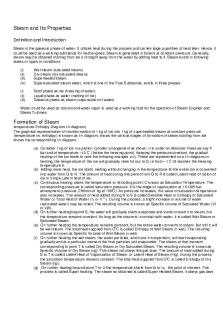Arterial pulse, its properties, examination. Sphygmogram PDF

| Title | Arterial pulse, its properties, examination. Sphygmogram |
|---|---|
| Author | Milly Smith |
| Course | Final Year Project |
| Institution | London Metropolitan University |
| Pages | 2 |
| File Size | 51.2 KB |
| File Type | |
| Total Downloads | 105 |
| Total Views | 142 |
Summary
Arterial pulse, its properties, examination. Sphygmogram...
Description
Arterial pulse, its properties, examination. Sphygmogram. Pulse is the swelling of the walls of blood vessels due to changes in blood pressure (systolic and diastolic). The pulse wave propagates faster than the blood stream (the pulse wave spread rate is faster than the blood stream flow rate). The cause of arterial pulse is left ventricular systole. We set the arterial pulse with two fingers. The pulse is determined where the artery exits the surface of the body or where it can be pressed against a solid surface. Measurement: Palpation (palpation) - palpation of well-pulsating blood vessels with a solid base: spinous, carotid, parotid arteries. Registration. It is also possible to record a pulse when the results are recorded on a curve-sphygmogram. Pulse types: • Arterial (sphygmogram) (pulse cause - ventricular systole). The arteries pulse all over. Venous (phlebogram). There are 5 teeth (pulse cause - atrial systole). Only the empty veins pulse. Features: Pulse Pulse rate is the number of pulse waves per minute. Normal pulse rate - 60-80 beats per minute. Persistent rare pulse - Bradycardia. Persistent too frequent tachycardia. Pulse rate changes during various functional conditions (excitement, sickness, physical activity, pulse rate in children, and lower frequency in athletes). Slowing down - when pressed n.vagus, due to an increase in intracranial fluid pressure, narrowing of the aortic opening, impaired conductive cardiac function and athletes. Pulse rate - Time intervals between pulse waves. If the intervals are the same, the pulse is rhythmic, and if the intervals are different, the arrhythmic. Slight arrhythmia is observed during respiratory phases. The pulse rate is slightly higher for inhalation and slightly less for exhalation (physiological arrhythmia). Pulse size - the difference between systolic and diastolic arterial blood pressure. It is directly proportional to systolic pressure and inversely proportional to the elasticity of the blood vessels. When bleeding occurs, pulse rate decreases
as systolic volume decreases. The pulse pressure in the elderly is higher because their vascular elasticity is reduced. The hardness of a pulse is defined as the force at which the pulse disappears. Evaluate necessarily with two fingers. The first attempts to clamp the blood vessel, and the second we detect whether or not the pulse is present. If you press a pulse to make it disappear, it requires a lot of force - the pulse is solid. Pulse rate is defined as the growth rate of a pulse wave. Evaluated by arterial pulse curve. Observe how fast the wave rises, how fast it descends. If it rises fast high pulse rate. This property is visible only after writing. Depends on stiffness of the vessel wall (the stiffest the vessel, the faster the speed). High pulse rate in a trained person or in pathology. Fast with aortic valve failure. Slow and low pulse rate - with valve stenosis. Arterial pulse curve - sphygmogram (arterial pulse graph): Anacrotic part - entire ascending curve (A B) Catacrotic part - entire descending part of the curve (BC, CD) There is dicrotic elevation in the catacrotic part. Cause: Blood is shed forward but hit the aortic crescent valves. That kick and it causes dicrotic rise. The systole covers the entire anacrotic portion and the catacrotic portion to the dicrotic elevation (AC). The diastole corresponds to the segment of the CD....
Similar Free PDFs

Steam and its properties
- 4 Pages

Radial pulse 2 - Notes
- 3 Pages

Sistema-Arterial
- 27 Pages

Hipertensão Arterial
- 7 Pages

Radial pulse 2 - lecture
- 3 Pages

Heartbeat Blood Pulse Sensor
- 5 Pages

Pulse-Chase Experiment
- 3 Pages

Pulse Rate Worksheet
- 5 Pages

Pulse Width Modulation (PWM)
- 8 Pages
Popular Institutions
- Tinajero National High School - Annex
- Politeknik Caltex Riau
- Yokohama City University
- SGT University
- University of Al-Qadisiyah
- Divine Word College of Vigan
- Techniek College Rotterdam
- Universidade de Santiago
- Universiti Teknologi MARA Cawangan Johor Kampus Pasir Gudang
- Poltekkes Kemenkes Yogyakarta
- Baguio City National High School
- Colegio san marcos
- preparatoria uno
- Centro de Bachillerato Tecnológico Industrial y de Servicios No. 107
- Dalian Maritime University
- Quang Trung Secondary School
- Colegio Tecnológico en Informática
- Corporación Regional de Educación Superior
- Grupo CEDVA
- Dar Al Uloom University
- Centro de Estudios Preuniversitarios de la Universidad Nacional de Ingeniería
- 上智大学
- Aakash International School, Nuna Majara
- San Felipe Neri Catholic School
- Kang Chiao International School - New Taipei City
- Misamis Occidental National High School
- Institución Educativa Escuela Normal Juan Ladrilleros
- Kolehiyo ng Pantukan
- Batanes State College
- Instituto Continental
- Sekolah Menengah Kejuruan Kesehatan Kaltara (Tarakan)
- Colegio de La Inmaculada Concepcion - Cebu






